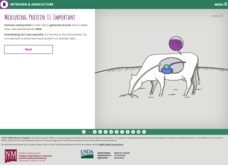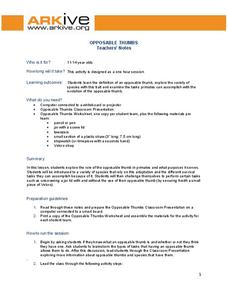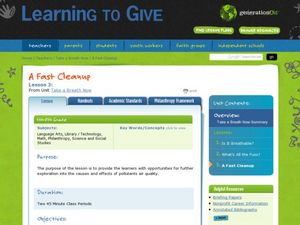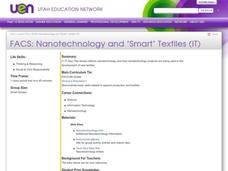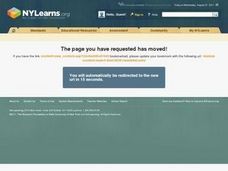Learning Games Lab
Nitrogen in Feed
Knowing what farmers are feeding livestock is just smart business. A WebQuest lesson helps learners build an understanding of the relationship between amino acids, nitrogen, and protein. With interactive instruction,...
Science 4 Inquiry
Musical Vibes with Palm Pipes
Ancient people used musical pipes as early as the third millennium BCE. Young scientists explore the workings of musical pipes to better understand the relationship with frequency, length of pipe, and sound waves. They determine the...
Curated OER
Ocean Animals
Very young learners identify ocean animal pictures by their correct name and create a book of ocean animals. They read books and lean ocean animal vocabulary using the SMART Board. A well-designed lesson plan!
Curated OER
Mitchell Road Investigation
Seventh graders discover the impact of man on the environment by analyzing plant and animal data. In this ecology lesson, 7th graders investigate a nearby road which many cars pass on and examine the impact of the road on the...
Curated OER
Classifying "Pastanimals"
Students explore biology by creating a poster presentation. In this animal classification lesson, students utilize a SMART board and practice organizing a group of animal shapes by placing them with similar animal families. Students...
Curated OER
Regulation - Human Nervous and Endocrine Systems
High schoolers explore homeostasis within the nervous and endocrine system with this Smart Board activity. In this biology lesson plan, students will fill in the know and want to know sections of a KWL chart as a class...
Curated OER
Animal Adaptations
Fourth graders view slides on the SMART board of physical and behavioral adaptations of animals. In this animal adaptations lesson plan, 4th graders also view a video and match a physical adaptation with the animal it pertains to.
ARKive
Opposable Thumbs
How do opposable thumbs help you complete certain tasks? An activity about evolutionary traits prompts learners to try writing their name, twist the lid off of a jar, and use tweezers to pick up a straw, first with their normal grip, and...
Curated OER
Astronomy
Students explore space science by utilizing education software. In this moon cycles lesson, students discuss the importance of the moon and the different phases we observe from earth. Students demonstrate the earth's orbit by creating a...
Curated OER
Save the Earth: It's Everyone's Home!
Students demonstrate how to make earth-smart choices. In this environmental awareness lesson, students listen to a short lecture on environmentally friendly products. Students invent an environmentally friendly product and complete an...
Curated OER
Human Fingerprints: No Two the Same
Sixth graders explore scientific observations by analyzing a group of data. In this fingerprint identification lesson, 6th graders identify the reasoning behind fingerprinting and create their own ink fingerprints. Students discuss the...
Curated OER
Weather Report
Students present the weather report in Spanish. In this weather lesson, students use weather vocabulary in Spanish. Students work in groups to present the local weather report in Spanish. Students film their report and present...
Curated OER
A Measure of Success
Students explore mathematics by cooking recipes in class. For this ingredient measuring lesson, students view several recipes in class they wish to cook and practice translating the recipe into a large enough creation that can feed the...
Curated OER
I Went Walking
Students take pictures. In this nature walk lesson, students read I Went Walking and brainstorm a list of things they might see on a nature trail. Students take pictures of things they see on the nature trail, write a caption for each...
Curated OER
A Fast Cleanup
Students discover the causes and effects of air pollution. In this stewardship lesson, students explore the Air Quality Index, research pollutants, and present their findings.
Curated OER
Levers - An Interactive Lesson
Seventh graders identify the different parts of a lever. In this physics lesson, 7th graders draw a lever and label the different parts. They use the interactive board to create their own lever.
Curated OER
To Float or Not to Float - A Lesson on Density
Students define density in their own words. In this physics lesson, students calculate density using mass and volume. They explain why some objects sink and some float.
Curated OER
Muscular and Skeletal Systems
How do muscles move bones? Find out using a built-in-class model. Pupils construct a hand model with paper and string, then follow a series of directions to explore the movement process. Discover additional information about the muscular...
PBS
Stories of Painkiller Addiction: Prescription Drug Abuse Awareness Campaign
The I-STOP law was designed to regulate the distribution and tracking of prescription drugs. After reading an article about its signing and implementation, middle and high schoolers work together to come up with their own ideas for an...
Curated OER
Water and the Water Cycle
Students explore the water cycle. For this water lesson, students apply the scientific method in activities that enable them to take note of the properties of water. Students record how water acts on different surfaces and share their...
Curated OER
FACS:Nanotechnology and "Smart" Textiles (IT)
Students obtain an understanding of the term "nanotechnology" and how nanotechnology products be used.
Science 4 Inquiry
Temperature of Inner Planets
Mars, Earth, and Venus contain atmospheres that generate weather. Young scientists explore the temperature of inner planets. They create a model simulating the greenhouse effect before researching and answering guided questions to...
Curated OER
An Introduction to the Night Sky and Movement Astronomy
Basically, this is an interactive exploration of educational astronomy software and an app. Young astronomers discover how the apparent motion of the sky relates to Earth's movements and the position of the observer. It is out of this...
Curated OER
"Finding Your Sweet Tooth"--An Introduction to the Dichotomous Key
Sixth graders classify candy according to observable characteristics. They use a dichotomous key to identify their bag of "treats." Thus, describe how dichotomous keys help to the identifying of organisms. Design a self-generated...
